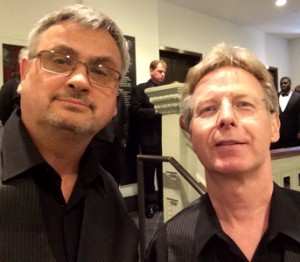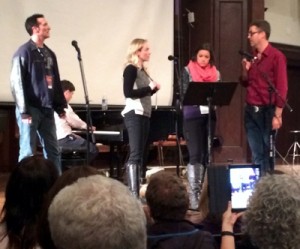Carnegie Hall will take your breath away. Standing on the storied old stage and looking out at 2,800 expectant concert goers in one of the world’s most prestigious venues is a dividing line in the history of any performer.

READY TO GO: From newchoir in Toronto, Georg Bjarnason, right, and I waiting to take the stage at Carnegie Hall.
It is a transformational experience, duly noted by a flood of emotions that well up seemingly out of nowhere, not only in the heat of performance but also during dress rehearsal — where before you, filling every one of the red cloth-covered seats, is history — and afterward, too, once you’ve climbed back up the staircase to your dressing room.
There is admiration of history and architecture, the way the grand auditorium’s multi-tier seating arrangement sweeps around you. There is a keen sense of destination and of destiny too, and in the midst of the storied opulence, no matter how politely stated, one is moved to acknowledge his own beginnings and the steps that led him here. Along with surges of elation and a sense of musical elevation comes a soaring joy, but also sobriety.
I got to experience this firsthand on March 29, as part of the Distinguished Concerts International New York presentation Total Vocal.
Effortlessly, the grand lady pulled the entirety of my vocal ability, and my performing instinct, out of me. I gave what she called for — without reservation, without checklists, without a shadow of uncertainty regarding preparation and without regard for the notion of stage-unworthiness. It seemed the thing to do. It wasn’t just me; the entire ensemble gathered for that Sunday afternoon performance appeared to be smitten in the same way.
They say appearing at Carnegie Hall changes you. You’ll never be the same performer again — mystically delivered from the place where you resided to a higher plane.
I’ve been witness to conversion experiences before. I’ve seen some sizzle but for a moment, while others tend to take. I cannot testify to the durability of others’ transformation, but I feel no need for witness nor for jury to adjudicate the integrity of mine.
It’s a keeper.
The transformation had actually begun hours before the performance, when being in her presence was yet new.
She beckoned before her history-laden seats were filled with new bodies for a new moment. Sometimes the excitement at being here, even in rehearsal, was awash in a wave of emotion — not exactly like the one experienced later, when we would look out to find those who have been witness to all the important milestones of our lives here now in this audience, but deeply felt nonetheless.
Actually, it began shortly after we had left our dressing rooms (in my case, Orchestra Room 6) and were brought down the backstage stairway that first time. Rounding the final corner, we got our first glimpse of the grandeur through the open stage-left door. We could see but a portion of the majestic stage and just a portion of the iconic red tiered seating, but it took our breath away just the same.
There were gasps. Some were moved to bring a hand to mouth. Hushed expressions of awe filtered like a quiet wind through the passageway where we otherwise waited in silence for our cue. I confess to grinning in total surrender as the transformation began to take root, and to letting the possession of the moment have its way once we were onstage and under the magically animated guidance of the inimitable Deke Sharon. (The arranger and conductor for the show, Sharon has been described by Entertainment Weekly as “the father of contemporary a cappella.”)

FINE-TUNING: Arranger-conductor Deke Sharon, at right, goes over some of the finer points with soloists Sean Altman, Kelley Jakle and Shelley Regner during rehearsal at New York Society for Ethical Culture concert hall.
Until a couple of days before, those of us from newchoir in Toronto had never met the other singers who would share parts with us on this grand stage. There were The Blenders and Serotonin from Australia and Vital Signs from North Carolina. There was vocal percussionist Chesney Snow, and vocalists Kelley Jakle and Shelley Regner, both of Pitch Perfect fame, and ex-Rockapella star Sean Altman. In all, it was a varied collection of soloists and ensemble groups who had only the sheet music of Deke Sharon arrangements in common before we met for rehearsals in the concert hall at the New York Society for Ethical Culture on Friday. Many moving parts and much to know, but inspired to the next level by the über-magical direction of Sharon, the performers came together and by Saturday night we knew we had a show.
I knew I would be happy for the experience, and would be thrilled to add Carnegie Hall to my resume. What I was not able to foresee was the great joy of being in that moment. There never was any threat of reckless exuberance, now, for that which is truly awe-inspiring commands reverence in kind, but the joy was palpable.
When it was over, those of us who had performed here together shook glad hands, and shook our heads too, in recognition of the majesty of just what we had experienced. Our paths to Carnegie Hall were as varied and as unlikely as was the count of our number, and surely were retraced privately by one and all in the time between our first breathtaking view from the stage and when the majestic auditorium was filled with 2,800 witnesses confirming that we belonged.
May anything else I ever do from a stage be deserving of the applause we received at Carnegie Hall that day.
